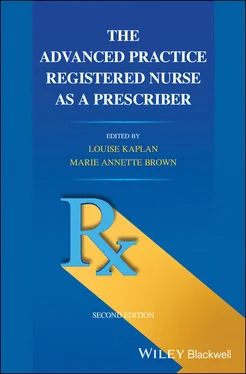In the practice setting, the APRN may be confronted with challenges to adopting the role of prescriber. In states with considerable limitations on autonomous prescribing, restrictions may be stipulated in practice agreements. Furthermore, specific clinical practice settings or individual characteristics of the collaborating physicians may limit the APRNs’ decision making, especially when an APRN choses a medication that differs from his or her preference. Collaborative practice agreements may specify that the physician has the ability to override an APRN’s prescribing decision.
The shift from professional preference and tradition to evidence‐based practice has been shown to be a key strategy for achieving quality patient care. Improved models for prescribing that increase the effectiveness of care and reduce error and cost are emerging from the rational prescribing and evidence‐based care movements. These models use clinical practice guidelines and electronic health records, exert more control over pharmaceutical marketing, and promote standards for formularies.
Commitment to these evidence‐informed models is essential for APRNs to improve quality and safety. Recently educated APRNs, steeped in careful attention to rational and evidence‐based prescribing, are likely to encounter situations with colleagues who may be unaware of current medication information. These situations often require assertiveness and communication skills that facilitate collegial sharing about continuously changing knowledge.
Prescriptive authority and responsibility
Changes to prescriptive authority for APRNs may be sponsored by legislators with limited understanding of the clinical abilities of the APRN (Safriet, 2002). Prescriptive authority carries responsibilities, even in states where collaboration or supervision is required. APRNs are accountable to patients, colleagues, the nursing profession, and society for their actions, decisions, and practice. As with any aspect of practice, errors or negligence in prescribing may result in disciplinary or legal action.
With all of the factors that influence the transition of the APRN as a prescriber, there will be a degree of uncertainty, and often anxiety, about prescribing. The transition from the RN role as the medication administrator to the APRN role as the medication prescriber can be viewed as a professionally invigorating challenge or as a distressing situation.
Professional relationships
Implementation of the APRN role requires the development of strong relationships with other healthcare professionals, patients, the profession, and society. The time and effort needed to establish and maintain these relationships may be demanding. The transition from the RN to the APRN role may change APRNs’ relationships with patients less than it changes relationships with other healthcare professionals. The most dramatic change for APRNs is likely to occur with physicians. APRNs’ level of prescribing expertise and the legal requirements of the prescriptive authority will influence relationships with physicians. A physician may be a colleague in the true sense of the word or may serve as a consultant or supervisor. The relationship between an APRN and a physician at its best will be similar to one’s relationship with another APRN colleague: fulfilling, supportive, and truly collaborative with the interests of the patient at its core. A problematic relationship with a collaborating or supervising physician can serve as a barrier to APRN practice and compromise patient care. In those situations, APRNs may experience isolation, invalidation, and marginalization.
It is essential for APRNs to enhance their skills to manage and improve contentious professional relationships. APRNs who skillfully challenge and improve strained collegial relationships can build professional acceptance for all APRNs as well as enhance the quality of their own work life. These are situations where support and collaboration from other APRNs may be particularly effective. Some practices, however, may employ only one APRN, and time for collegial interaction at one’s workplace may be limited.
The practice relationships that are legally required between APRNs and physicians vary from state to state. The majority of states still require some type of collaborative practice and some limit prescribing for specific medications or controlled drugs. For example, Alabama has one of the most restrictive scopes of advanced practice in the United States. Neither CNSs nor CRNAs may prescribe. For NPs and CNMs, prescribing limits include the following:
The drug type, dosage, quantity prescribed, and number of refills shall be authorized and signed by the collaborating physician.
The drug shall be on the formulary recommended by the joint committee and adopted by the State Board of Medical Examiners and the Board of Nursing.
A certified registered NP or a CNM may not initiate a call‐in prescription in the name of the collaborating physician for any drug, whether legend or CS, which the certified registered NP is not authorized to prescribe under the protocol, with certain exceptions (Alabama State Board of Nursing, 2020).
In states with restrictive practice laws, APRNs may be subject to direct oversight of a physician regardless of their expertise. Beyond a legal requirement for collaboration or supervision, physicians may view APRNs differently from how APRNs view themselves. A study in a midwestern VA region investigated NPs’ and physicians’ perceptions of the NP role, the degree of collegiality between the NPs and physicians, and the extent to which NPs felt accepted (Fletcher et al., 2007). NPs viewed themselves as autonomous and utilized physician collaborators in a consultation role. Physicians viewed the NPs as “extenders” (who serve a purpose for the MDs) to “free‐up their time.” In both groups, the relationship between the physician and NP was seen as collegial, and physicians were satisfied with NP practice contributions. These data highlight how, despite interprofessional relationships that seem collegial and satisfying to both APRNs and MDs, physicians may maintain a traditional, hierarchical view of APRNs promoted by organized medicine. At the same time, there are many clinical settings where APRNs are viewed as colleagues. One study of primary care physicians and NPs in Missouri, a restricted practice state, revealed how physicians and NPs had similar views on many issues and their responses to each other lacked defensiveness or conflict. Moreover, NPs did not view physicians as impediments to their work with patients and physicians respected NPs and viewed their skills favorably (Kraus & DuBois, 2017).
Relationships with pharmacists are particularly important for the APRN prescriber. The pharmacist is the expert on pharmacological agents, while the APRN applies knowledge of medications contextually to the patient situation, patient preferences, and expectations of best practice. Ideally, APRNs work with pharmacists as colleagues who have the same goal of appropriate and safe medication management and a commitment to quality patient care.
A patient’s pharmacological management may involve collaboration with a specialized practitioner, for example, a physician or APRN who practices in endocrinology. Different collaborative approaches may be used.
A patient consultation is made with the specialist for evaluation and development of a medication regimen. The regimen is implemented and monitored by the APRN.
A patient is referred to a specialist who assumes care for specific health needs of the patient. The APRN typically maintains the role as the coordinator of care.
It is essential, however, that patients with a variety of complex problems who receive care from multiple specialists who prescribe medications have coordinated care and medications monitored by the primary care APRN.
Читать дальше












